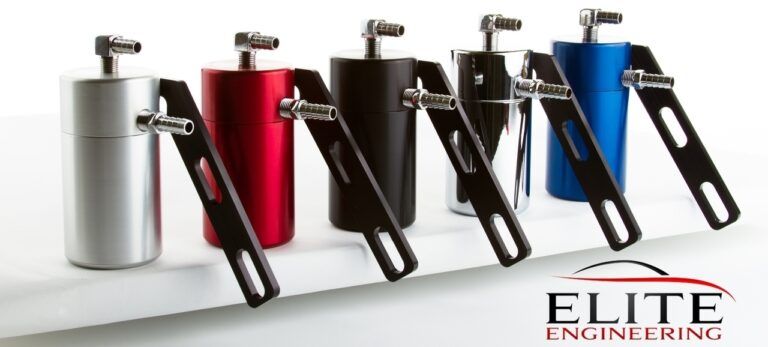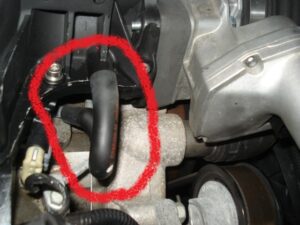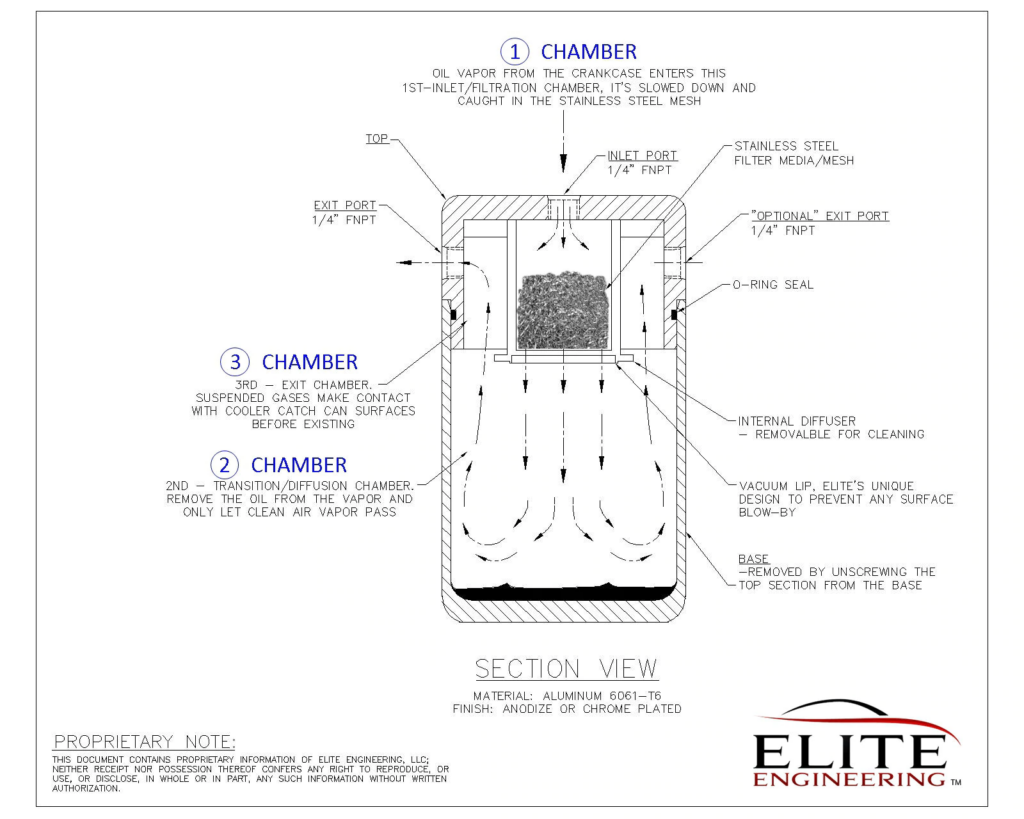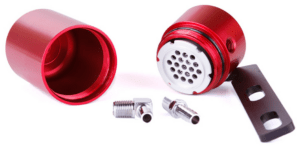Should you use an oil catch can on your 2004-2006 Pontiac GTO? Absolutely! The PCV (Positive Crankcase Ventilation) system used on General Motors LS engines uses the intake manifold to burn off unwanted crankcase fumes. These fumes contain oil that goes right into the intake manifold. Oil in the intake manifold means oil on the cylinder head valves, oil in the combustion chamber, and then eventually it all gets passed through the exhaust system.
Passing through the exhaust system unfortunately is not always the case of what happens. The PCV valve controls the amount of crankcase flow volume depending on the engine’s load. With large throttle openings (high engine loads), more vapor gases that can contain oil are produced. The more the PCV system flows, the more oil vapor is routed to the intake manifold. A small amount of that ignited oil vapor can leak past the piston rings and end up in the crankcase. This leakage is often referred to as a “blow-by” or leakage past the pistons. Some of the oil mist and other products settle along in the engine and intake manifold and over time form sludge or gunk.
Why did the engine get designed this way? Simple, to reduce emissions and is an easy cure to prevent your engine from vapor locking. Without the PCV system, your engine would build up pressure caused by oil and gas fumes and would cause seals to go bad and create oil leaks. Even worse it could lock up the engine completely.
Below you will see the images of exactly how the PCV System works. The engine simply uses a rubber fuel line to push gases and vapor from the crankcase outward and directed back through the intake manifold. The hose is “U” shaped and fairly easy to find. From under the hood look on the left side of the engine just behind the throttle body. The lower part of the hose is attached to the crankcase where vapor is expelled from the engine. The upper part of the hose is where the vapors re-enter the intake manifold to be burned off as exhaust gases.
This is where an Oil Catch Can come into play. The oil catch can is a filter that catches the oil and dirt from the crankcase PCV system before it enters your intake manifold, only allowing the air to pass through as it should. Below is a video of the results of adding an oil catch can to your engine:
How It Works
The object here is to filter the vapor of oil and debris before it re-enters the intake manifold. The oil catch is installed between the crankcase PCV relief valve (vapor exit) and the inlet of the PCV System on the intake manifold. For the example, I am going to use Elite Engineering Oil Catch Can. Below you will see a diagram of a cutaway version of the oil catch can and how it filters oil and debris before they enter the intake manifold:
As you can see, oil vapor is directed to the inlet of the oil catch can and run through a filter, which catches oil and debris. The Oil and debris are then captured in the base of the can which can be removed to be emptied and cleaned when full. The remaining vapor is then directed to the exit of the oil catch can and enters the intake manifold and operates in a normal manner. The difference here is the engine is disposing of clean filtered vapor without the risk of oil and debris entering the intake manifold and the engine.
Are You Ready To Add An Oil Catch Can To Your Vehicle?
There are a few different companies that make oil catch cans for 2004-2006 Pontiac GTO. You are visiting Mark Quitter Racing, which means I’m only going to tell you to purchase the best one for our vehicles.
Elite Engineering is the best in the business when it comes to Oil Catch Cans. They offer the best filtering system to protect your engine, and their catch cans are very easy to install and maintain. Each catch can include a bottom catch can reservoir that screws onto the top of the unit, and is sealed with a built-in O-ring. Inspection and cleaning are easy by simply removing the bottom of the unit reservoir by unscrewing it by hand, without disturbing the mounting system or hoses.
The following is taken directly from the Elite Engineering 2004-2006 Pontiac GTO Oil Catch Can product page:
|
Negative Effects of your Stock PCV System: There are various negative effects when excess oil vapor contaminates the intake system from the stock PCV system – such as:
Bottom line: Excessive amounts of oil vapor in the intake manifold is detrimental to your engine! Solution: Install the Elite Engineering PCV Oil Catch Can! Ultimate Function: |
Where To Purchase
Elite Engineering Oil Catch Cans come in a variety of colors and each kit comes with everything you need to install it on your vehicle. Installation can be done in approximately 20 minutes using basic hand tools.
Each standard kit comes with the following:
- Catch Can assembly is beautifully anodized in a choice of available colors, complete with 3/8″ barbed inlet/outlet hose fittings.
- Custom machined mounting bracket to fit your specific vehicle and application
- All Stainless steel mounting hardware.
- 3/8″ ID fuel and oil vapor compatible hose.
- PCV adapter hardware.
- Black zinc plated hose clamps.
- Brass Hose Barb fittings are standard, upgrade to Nickel Plated or Chrome Fittings for that custom look
You can purchase an Elite Engineering Oil Catch Can for your 2004-2006 Pontiac GTO by clicking the following link:
Purchase 2004-2006 Pontiac GTO Elite Engineering Oil Catch Can
Next, download the installation instructions below. Installation instructions are for Corvette LS2 which will be the same instructions for 2004-2006 Pontiac GTO, including both LS1 and LS2 engines.
| DOWNLOAD (.pdf format) |
| 2004-2006 Pontiac GTO Oil Catch Can Installation Instructions |
For video install instructions help, I found this video on YouTube:
Maintenance
Maintaining and inspecting the Elite Engineering Oil Catch Can is extremely easy. The Oil Catch Can will do exactly what it says it does, catch oil. The bottom portion of the catch can is a reservoir that will need to be checked and emptied from time to time. If you do not empty the catch can it can become very full of oil, causing oil to get backed up into the intake manifold, which is exactly what we are trying to avoid. Indications of a full oil catch can will be white or blueish smoke coming from the exhaust due to oil being burned in the combustion chamber of the engine. You can see in the picture below how the Oil Catch Can have a removable reservoir:
At every oil change or before, simply screw off by hand the bottom reservoir of the catch can. If standing in front of the front bumper and looking at the catch can, you would turn in a clockwise motion to remove it. Be careful not to tip the reservoir when removing it, there will be oil in there you will want to inspect. Look in the reservoir and you should see some oil, which is good. This means the catch can is doing its job. I would expect to find anywhere from a tablespoon to a couple of shot glasses ( 3 ounces) of oil every 3000 miles depending on your driving habits. Also, look for any dirt and debris as well as check for metal shavings. Hopefully, the only thing you find is oil. Empty the reservoir and use a paper towel to clean it out. Before re-installing the catch can reservoir, make sure the rubber o-ring is still on the catch as well. Replace the reservoir onto the catch can by turning counterclockwise (standing in front of the front bumper). Hand tighten and you’re done.








